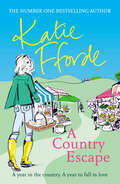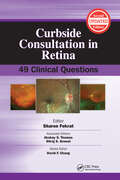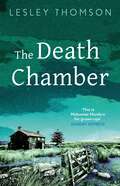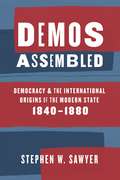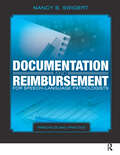- Table View
- List View
Clinical Pediatric Anesthesia: A Case-Based Handbook
by Erin S. Williams, Olutoyin A. Olutoye, Catherine P. Seipel And Titilopemi A. O. AinaThis second edition of Clinical Pediatric Anesthesia: A Case-Based Handbook offers a comprehensive review of the options, advantanges, and disadvantages of different aspects of the perioperative management of the pediatric patient, as well as examples of a wide range of relevant clinical scenarios. Chapters are organized into 15 sections and cover the field of pediatric anesthesiology with a point-of-care approach. Written by a team of over 50 Pediatric Anesthesiologists at tertiary children's hospitals, this highly accessible text provides readers with multiple approaches to the anesthetic care of the pediatric patient. Each chapter includes an introduction to the topic, followed by learning objectives, clinical vignettes, and a discussion section styled in a question-and-answer format, concluding with a summary of the highest-yield and most salient information. Chapters also provide annotated references and suggestions for further reading to facilitate in-depth study of topic. The variety of cases presented, along with the contributors' expertise, render valuable real-life clinical situations that promote critical thinking and evaluation necessary for all pediatric anesthesiology consultants.
Collaborations Within and Between Dramatherapy and Music Therapy: Experiences, Challenges and Opportunities in Clinical and Training Contexts
by Susan Greenhalgh Jo Tomlinson Helen Odell-Miller Grace Thompson Ditty Dokter Eleanor Richards Dr Sue JenningsMusic therapy and dramatherapy share many of the same techniques and purposes, yet the full potential of combining aspects of the two disciplines is yet to be explored. This book examines the ways in which they can be brought together, and unpacks the various contexts in which this approach can be taught and put to practice.
Colonial Capitalism and the Dilemmas of Liberalism
by Onur Ulas InceBy the mid-nineteenth century, Britain celebrated its possession of a unique "empire of liberty" that propagated the rule of private property, free trade, and free labor across the globe. The British also knew that their empire had been built by conquering overseas territories, trading slaves, and extorting tribute from other societies. Set in the context of the early-modern British Empire, Colonial Capitalism and the Dilemmas of Liberalism paints a striking picture of these tensions between the illiberal origins of capitalism and its liberal imaginations in metropolitan thought. Onur Ulas Ince combines an analysis of political economy and political theory to examine the impact of colonial economic relations on the development of liberal thought in Britain. He shows how a liberal self-image for the British Empire was constructed in the face of the systematic expropriation, exploitation, and servitude that built its transoceanic capitalist economy. The resilience of Britain's self-image was due in large part to the liberal intellectuals of empire, such as John Locke, Edmund Burke, and Edward Gibbon Wakefield, and their efforts to disavow the violent transformations that propelled British colonial capitalism. Ince forcefully demonstrates that liberalism as a language of politics was elaborated in and through the political economic debates around the contested meanings of private property, market exchange, and free labor. Weaving together intellectual history, critical theory, and colonial studies, this book is a bold attempt to reconceptualize the historical relationship between capitalism, liberalism, and empire in a way that continues to resonate with our present moment.
Coming Home to Autism: A Room-by-Room Approach to Supporting Your Child at Home after ASD Diagnosis
by Tara Leniston Rhian GroundsThis friendly book offers a blueprint for family life with autism by using rooms inthe home to represent key developmental areas. There are ideas and routines totry at home, including advice on toilet training, diet and nutrition, sensory play,and much more, and you can dip in and out of chapters as you need information.
Complementary Therapies in Maternity Care: An Evidence-Based Approach
by Denise TiranAn extensive resource for midwives and other professionals with complete information on how to use complemetary therapies during pregnancy and childbirth. Covering all the necessary scientific, legal, ethical, and health issues, it gives you the knowledge and confidence to use complemetary therapies safely and effectively.
A Comprehensive Guide to Daoist Nei Gong
by Damo MitchellA complete and detailed explanation of the Nei Gong process. Explaining the philosophy at the core of Daoist Nei Gong, and illustrated with detailed figures throughout, this fascinating text will be of interest to practitioners of Qi Gong, martial arts and practitioners, and to anyone interested in Eastern philosophy.
The Comprehensive Manual of Therapeutic Exercises: Orthopedic and General Conditions
by Elizabeth BryanTherapeutic exercises can be found spread out amongst numerous texts, handouts, card boxes, and websites, which has sent clinicians, practitioners, and trainers searching for reliable, evidence-based exercises for the entire body, all packaged into a single, all-inclusive manual. To that end, The Comprehensive Manual of Therapeutic Exercises: Orthopedic and General Conditions was written as a fundamental resource on exercise theory and techniques, and as a comprehensive guide for designing exercise programs. Dr. Elizabeth Bryan has compiled thousands of clinically relevant exercises to create a text that will teach students theory and proper application that they will then return to again and again in their career as a reference to aid in designing evidence-based exercise programs for their clients or patients. Introductory chapters cover exercise parameters, exercise progression, the importance of form, muscle soreness, and a reference for body position terminology, then subsequent chapters are organized by body area to cover most of the clinical exercises in use today. Each exercise includes photographs, a list of muscle systems that will be affected, specific substitutions to look for, and detailed instructions directed at students and clinicians. Also included are sections devoted to protocols and specialty exercises including yoga and tai chi. Embracing the principles of evidence-based practice, “Where’s the Evidence?” boxes are prominently featured throughout the text to support the exercises and theory with up-to-date, relevant, sufficient, valid, and reliable studies. Combining theory with practice, The Comprehensive Manual of Therapeutic Exercises: Orthopedic and General Conditions is an essential tool for students as well as clinicians, practitioners, or trainers to find the most appropriate exercises for their client’s or patient’s needs and apply them properly.
The Comprehensive Manual of Therapeutic Exercises: Orthopedic and General Conditions
by Elizabeth BryanTherapeutic exercises can be found spread out amongst numerous texts, handouts, card boxes, and websites, which has sent clinicians, practitioners, and trainers searching for reliable, evidence-based exercises for the entire body, all packaged into a single, all-inclusive manual. To that end, The Comprehensive Manual of Therapeutic Exercises: Orthopedic and General Conditions was written as a fundamental resource on exercise theory and techniques, and as a comprehensive guide for designing exercise programs. Dr. Elizabeth Bryan has compiled thousands of clinically relevant exercises to create a text that will teach students theory and proper application that they will then return to again and again in their career as a reference to aid in designing evidence-based exercise programs for their clients or patients. Introductory chapters cover exercise parameters, exercise progression, the importance of form, muscle soreness, and a reference for body position terminology, then subsequent chapters are organized by body area to cover most of the clinical exercises in use today. Each exercise includes photographs, a list of muscle systems that will be affected, specific substitutions to look for, and detailed instructions directed at students and clinicians. Also included are sections devoted to protocols and specialty exercises including yoga and tai chi. Embracing the principles of evidence-based practice, “Where’s the Evidence?” boxes are prominently featured throughout the text to support the exercises and theory with up-to-date, relevant, sufficient, valid, and reliable studies. Combining theory with practice, The Comprehensive Manual of Therapeutic Exercises: Orthopedic and General Conditions is an essential tool for students as well as clinicians, practitioners, or trainers to find the most appropriate exercises for their client’s or patient’s needs and apply them properly.
Conversation Starters for Direct Work with Children and Young People: Guidance and Activities for Talking About Difficult Subjects (Practical Guides for Direct Work)
by Audrey Tait Becky DunnSome children face traumatic or difficult events in their lives, and it's essential that they are helped to understand such events and given permission to talk. To do this, helping adults need to be equipped and confident to start these conversations.Conversation Starters for Direct Work with Children and Young People provides guidance and support for any adult who needs to talk to children about difficult issues. The issues covered include domestic abuse and drug use, mental health issues, adoption and fostering, family illness and bereavement, as well as giving evidence in court.Co-authored by the bestselling author of Direct Work with Vulnerable Children and Direct Work with Family Groups, this book combines seasoned practice wisdom with practical examples and activity ideas to enable you to best help the children in your care.
Cooking for the Senses: Vegan Neurogastronomy
by Gregor Law Jennifer Peace Peace RhindPresenting a new way of looking at food and flavour, this recipe book explains how the palate works and explores the senses to help you maximise flavour in your kitchen. Beautifully packaged, this first book on neurogastronomy for the home cook includes over 100 vegan recipes.
A Country Escape: From the #1 bestselling author of uplifting feel-good fiction
by Katie FfordeA year in the country. A year to fall in love . . . Warm, funny and wonderfully romantic, this is Katie Fforde at her very best.‘Katie really is the queen of uplifting, feel good romance.’ AJ Pearce'Modern-day Austen. Great fun' Red'Delicious - gorgeous humour and the lightest of touches' Sunday Times__________Fran has always wanted to be a farmer. And now it looks as if her childhood dream is about to come true.She has just moved to her aunt's beautiful but very run-down farm in the Cotswolds. If she can turn the place around in a year, the farm will be hers.But Fran knows nothing about farming. She might even be afraid of cows ...She'll need help, not just from her best friend Issi, but also from her wealthy and very eligible neighbour - who might just have his own reasons for being so supportive.Is it the farm he is interested in? Or Fran herself?__________Readers can't get enough of A Country Escape . . .***** 'Just charming, gentle, wonderful fun. I adore Katie Fforde.'***** 'It's always a pleasure to live in Katie Fforde's world for a few days.'***** 'I absolutely loved, loved this book. It was clean, passionate, and filled with characters who were delightful, both good and bad.'***** 'What a beautiful heartwarming story. A easy five stars.'***** 'Katie Fforde has written a gorgeous heartwarming book. I immediately fell in love with her beautiful setting.'
Create, Perform, Teach!: An Early Years Practitioner's Guide to Developing Your Creativity and Performance Skills
by Nikky SmedleyPacked with tips and simple activities, this practical guide helps early years practitioners to develop their creativity and performance skills to engage children more effectively. It includes advice on using storytelling, role play, sensory play, puppetry, nonverbal play, photography and much more.
Creative Approaches to CBT: Art Activities for Every Stage of the CBT Process
by Patricia SherwoodRelevant for a wide range of clients, this book provides creative exercises for every stage of the cognitive behavioural therapy (CBT) process. Each chapter focuses on a different element of CBT and gives step-by-step instructions for creative activities which enhance the work being done. Case examples reveal how this works in practice.
Creative Ideas for Assessing Vulnerable Children and Families
by Katie WrenchProviding creative ideas and activities to support busy social workers in assessing the needs of vulnerable children and their families or caregivers, this book is based upon tried-and-tested methods from an experienced social worker and offers handy practical hints throughout. Ideal as a quick reference guide for everyday practice.
Curbside Consultation in Retina: 49 Clinical Questions (Curbside Consultation in Ophthalmology)
by Sharon FekratCurbside Consultation in Retina: 49 Clinical Questions has been updated into a Second Edition! The Second Edition contains new questions and is completely updated!Curbside Consultation in Retina: 49 Clinical Questions, Second Edition contains new questions and brief, practical, and evidence-based answers to the most frequently asked questions that are posed during a “curbside consultation” between surgical colleagues. Dr. Sharon Fekrat, along with associate editors Drs. Akshay Thomas and Dilraj Grewal, have designed this unique reference that offers expert advice, preferences, and opinions on a variety of clinical questions commonly associated with the retina. The unique Q&A format provides quick access to current information related to the retina with the simplicity of a conversation between two colleagues. Images and references are included to enhance the text and to illustrate clinical diagnoses. Some of the questions that are answered inside the Second Edition include: Anything coming down the pike yet for dry age-related macular degeneration? How long are we going to have to keep doing frequent intravitreal injections -- Any other options anytime soon? What are we waiting for? What is hemorrhagic occlusive retinal vasculitis and why do I need to know about it? Are we ever going to use stem cells? For what? What’s the scoop? I just can’t keep up with all of the clinical trial acronyms. Can you tell me what study each refers to? What systemic medications require periodic fundus evaluation, what am I looking for, and what tests do I do? Explain all of these new anticoagulants to me. Should I consider stopping them preoperatively? Curbside Consultation in Retina: 49 Clinical Questions, Second Edition provides information basic enough for residents while also incorporating expert pearls that even high-volume ophthalmologists and specialists will appreciate. Optometrists, ophthalmologists, ophthalmologists-in-training, and even retina specialists will benefit from the user-friendly and casual format as well as the expert advice contained within.
Curbside Consultation in Retina: 49 Clinical Questions (Curbside Consultation in Ophthalmology)
by Sharon FekratCurbside Consultation in Retina: 49 Clinical Questions has been updated into a Second Edition! The Second Edition contains new questions and is completely updated!Curbside Consultation in Retina: 49 Clinical Questions, Second Edition contains new questions and brief, practical, and evidence-based answers to the most frequently asked questions that are posed during a “curbside consultation” between surgical colleagues. Dr. Sharon Fekrat, along with associate editors Drs. Akshay Thomas and Dilraj Grewal, have designed this unique reference that offers expert advice, preferences, and opinions on a variety of clinical questions commonly associated with the retina. The unique Q&A format provides quick access to current information related to the retina with the simplicity of a conversation between two colleagues. Images and references are included to enhance the text and to illustrate clinical diagnoses. Some of the questions that are answered inside the Second Edition include: Anything coming down the pike yet for dry age-related macular degeneration? How long are we going to have to keep doing frequent intravitreal injections -- Any other options anytime soon? What are we waiting for? What is hemorrhagic occlusive retinal vasculitis and why do I need to know about it? Are we ever going to use stem cells? For what? What’s the scoop? I just can’t keep up with all of the clinical trial acronyms. Can you tell me what study each refers to? What systemic medications require periodic fundus evaluation, what am I looking for, and what tests do I do? Explain all of these new anticoagulants to me. Should I consider stopping them preoperatively? Curbside Consultation in Retina: 49 Clinical Questions, Second Edition provides information basic enough for residents while also incorporating expert pearls that even high-volume ophthalmologists and specialists will appreciate. Optometrists, ophthalmologists, ophthalmologists-in-training, and even retina specialists will benefit from the user-friendly and casual format as well as the expert advice contained within.
The Death Chamber (The Detective's Daughter #6)
by Lesley ThomsonFrom the number one bestseller of The Detective's Daughter. For forty years, someone has got away with murder... Forty years ago, seventeen-year-old Cassie Baker took a shortcut home from a small Cotswolds village, and was never seen again. Twenty years later, Cotswolds police found Cassie's remains while searching for another missing teenager, Bryony Motson. Bryony's body was never found. Now Stella Darnell, cleaner and private detective, has decided to find out what happened to Bryony. She knows her investigation will be dangerous. Because, for too long, someone has got away with murder. Someone who will do anything to keep it that way... PRAISE FOR LESLEY THOMSON: 'In the best traditions of the classic whodunnit, this is Midsomer Murders for grown-ups' Jake Kerridge, SUNDAY EXPRESS. 'Lesley Thomson is a class above' IAN RANKIN. 'Stella Darnell is one of the most original characters in British crime fiction' Joan Smith, SUNDAY TIMES. 'A wonderfully eerie setting, unique characters and a chilling plot' ELLY GRIFFITHS. 'Clever, credible and memorable' LITERARY REVIEW. 'Gloriously well-written... Thomson creates a rich and sinister world that is utterly unique' WILLIAM SHAW.
Dementia, Sex and Wellbeing: A Person-Centred Guide for People with Dementia, Their Partners, Caregivers and Professionals
by Danuta LipinskaTackling the 'last taboo' in dementia care, this book demonstrates how professionals can support the sexuality of people with dementia. It includes advice on safeguarding and accessible explanations of how cognitive changes affect sexual behaviour and expression.
Democracy and Climate Change (ISSN)
by Frederic HanuschDemocracy and Climate Change explores the various ways in which democratic principles can lead governments to respond differently to climate change. The election cycle can lead to short-termism, which often appears to be at odds with the long-term nature of climate change, with its latency between cause and effect. However, it is clear that some democracies deal with climate change better than others, and this book demonstrates that overall stronger democratic qualities tend to correlate with improved climate performance.Beginning by outlining a general concept of democratic efficacy, the book provides an empirical analysis of the influence of the quality of democracy on climate change performance across dozens of countries. The specific case study of Canada’s Kyoto Protocol process is then used to explain the mechanisms of democratic influence in depth. The wide-ranging research presented in the book opens up several new and exciting avenues of enquiry and will be of considerable interest to researchers with an interest in comparative politics, democracy studies and environmental policies.
Demos Assembled: Democracy and the International Origins of the Modern State, 1840–1880
by Stephen W. SawyerAn intelligent, engaging, and in-depth reading of the nature of the state and the establishment of the modern political order in the mid-nineteenth century. Previous studies have covered in great detail how the modern state slowly emerged from the early Renaissance through the seventeenth century, but we know relatively little about the next great act: the birth and transformation of the modern democratic state. And in an era where our democratic institutions are rife with conflict, it’s more important now than ever to understand how our institutions came into being. Stephen W. Sawyer’s Demos Assembled provides us with a fresh, transatlantic understanding of that political order’s genesis. While the French influence on American political development is well understood, Sawyer sheds new light on the subsequent reciprocal influence that American thinkers and politicians had on the establishment of post-revolutionary regimes in France. He argues that the emergence of the stable Third Republic (1870–1940), which is typically said to have been driven by idiosyncratic internal factors, was in fact a deeply transnational, dynamic phenomenon. Sawyer’s findings reach beyond their historical moment, speaking broadly to conceptions of state formation: how contingent claims to authority, whether grounded in violence or appeals to reason and common cause, take form as stateness.
Diving Medical Acupuncture: Treatment and Prevention of Diving Medical Problems with a Focus on ENT Disorders
by Janneke VermeulenAn overview of acupuncture treatments for a wide range of health issues that can prevent, complicate or result from diving and other water sports. Applies knowledge from Western Diving Medicine and Chinese medicine to present effective treatment for the most common ear, nose and throat problems associated with diving.
Documentation and Reimbursement for Speech-Language Pathologists: Principles and Practice
by Nancy SwigertAlthough it is the least noticed by patients, effective documentation is one of the most critical skills that speech-language pathologists must learn. With that in mind, Documentation and Reimbursement for Speech-Language Pathologists: Principles and Practiceprovides a comprehensive guide to documentation, coding, and reimbursement across all work settings.The text begins with section 1 covering the importance of documentation and the basic rules, both ethical and legal, followed by an exploration of the various documentation forms and formats. Also included are tips on how to use electronic health records, as well as different coding systems for diagnosis and for procedures, with an emphasis on the link between coding, reimbursement, and the documentation to support reimbursement.Section 2 explains the importance of focusing on function in patient-centered care with the ICF as the conceptual model, then goes on to cover each of the types of services speech-language pathologists provide: evaluation, treatment planning, therapy, and discharge planning. Multiple examples of forms and formats are given for each.In section 3, Nancy Swigert and her expert team of contributors dedicate each chapter to a work setting in which speech-language pathologists might work, whether adult or pediatric, because each setting has its own set of documentation and reimbursement challenges. And since client documentation is not the only kind of writing done by speech-language pathologists, a separate chapter on “other professional writing” includes information on how to write correspondence, avoid common mistakes, and even prepare effective PowerPoint presentations.Each chapter in Documentation and Reimbursement for Speech-Language Pathologists contains activities to apply information learned in that chapter as well as review questions for students to test their knowledge. Customizable samples of many types of forms and reports are also available.Included with the text are online supplemental materials for faculty use in the classroom.Documentation and Reimbursement for Speech-Language Pathologists: Principles and Practice is the perfect text for speech-language pathology students to learn these vital skills, but it will also provide clinical supervisors, new clinicians, and speech-language pathologists starting a private practice or managing a department with essential information about documentation, coding, and reimbursement.
Documentation and Reimbursement for Speech-Language Pathologists: Principles and Practice
by Nancy SwigertAlthough it is the least noticed by patients, effective documentation is one of the most critical skills that speech-language pathologists must learn. With that in mind, Documentation and Reimbursement for Speech-Language Pathologists: Principles and Practiceprovides a comprehensive guide to documentation, coding, and reimbursement across all work settings.The text begins with section 1 covering the importance of documentation and the basic rules, both ethical and legal, followed by an exploration of the various documentation forms and formats. Also included are tips on how to use electronic health records, as well as different coding systems for diagnosis and for procedures, with an emphasis on the link between coding, reimbursement, and the documentation to support reimbursement.Section 2 explains the importance of focusing on function in patient-centered care with the ICF as the conceptual model, then goes on to cover each of the types of services speech-language pathologists provide: evaluation, treatment planning, therapy, and discharge planning. Multiple examples of forms and formats are given for each.In section 3, Nancy Swigert and her expert team of contributors dedicate each chapter to a work setting in which speech-language pathologists might work, whether adult or pediatric, because each setting has its own set of documentation and reimbursement challenges. And since client documentation is not the only kind of writing done by speech-language pathologists, a separate chapter on “other professional writing” includes information on how to write correspondence, avoid common mistakes, and even prepare effective PowerPoint presentations.Each chapter in Documentation and Reimbursement for Speech-Language Pathologists contains activities to apply information learned in that chapter as well as review questions for students to test their knowledge. Customizable samples of many types of forms and reports are also available.Included with the text are online supplemental materials for faculty use in the classroom.Documentation and Reimbursement for Speech-Language Pathologists: Principles and Practice is the perfect text for speech-language pathology students to learn these vital skills, but it will also provide clinical supervisors, new clinicians, and speech-language pathologists starting a private practice or managing a department with essential information about documentation, coding, and reimbursement.
The Economics of Iraq: Ancient past to distant to future
by Amer K. HirmisMeticulously researched and written by Dr Amer K. Hirmis the book takes readers 6000 years back to early Mesopotamian polity, culture, and religious codes which shaped the economy, and continue to shape much of the body of Iraq's polity, economy and society today. Economic inefficiency, inequality and lack of sufficient employment are common threads that run throughout Mesopotamian/Iraqi economic history. The persistence of poverty, high unemployment, conscious discrimination against women, and a polity dictating blind allegiance and obedience from the subjects to the ruler, denied the Iraqis achieving economic development, the ultimate aim of which is the sustained improvement of the well-being of the people. Even when economic growth was attained, it was desperately non-inclusive. With a novel approach to economic development, this book examines Iraq's economy over the past 100 years. It establishes the historical roots in the consumption patterns, nature of the producers, the economic structure, trade, monetary and fiscal policy and resource allocation. In all these areas the echoes from the ancient past are striking. The principles of Sumerian taxes are still applied in present-day Iraq. The book proposes a set of conditions, which will need to be created for Iraq to achieve economic development and functional democracy, in the distant future.









